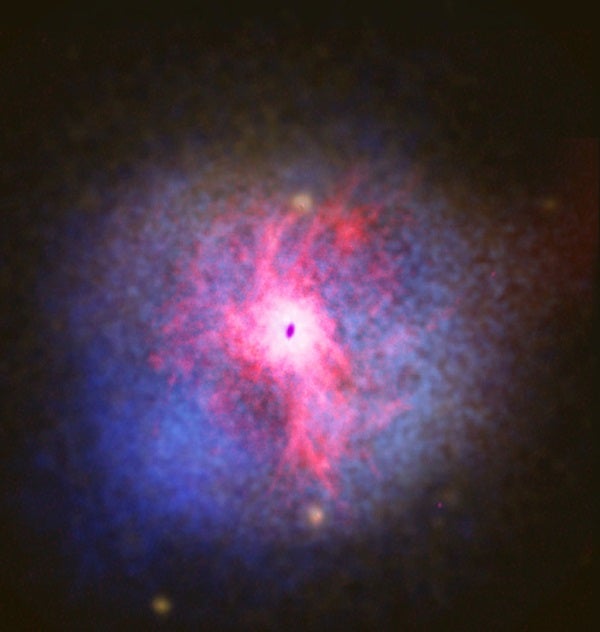Giant elliptical galaxies are the most puzzling type of galaxy in the universe. Since they mysteriously shut down their star-forming activity and remain home only to the longest-lived of their stars — which are low-mass ones and appear red — astronomers often call these galaxies “red and dead.”
Up until now, it was thought that red-and-dead galaxies were poor in cold gas — the vital raw material from which stars are born. While cold gas is abundant in spiral galaxies with lively star formation, the lack of it in giant ellipticals seemed to explain the absence of new stars.
Astronomers have long been debating the physical processes leading to the end of their star formation. They speculated that these galaxies somehow expelled the cold gas, or that they had simply used it all to form stars in the past. Although the reason was uncertain, one thing seemed to have been established: These galaxies are red and dead because they no longer possess the means to sustain the production of stars.
This view is being challenged by a new study based on data from the European Space Agency’s (ESA) Herschel Space Observatory.
“We looked at eight giant elliptical galaxies that nobody had looked at with Herschel before, and we were delighted to find that, contrary to previous belief, six out of eight abound with cold gas,” said Norbert Werner from Stanford University in California.
This is the first time that astronomers have seen large amounts of cold gas in red-and-dead galaxies that are not located at the center of a massive galaxy cluster.
The cold gas manifested itself through far-infrared emissions from carbon ions and oxygen atoms. Herschel’s sensitivity at these wavelengths was instrumental to the discovery.
“While we see cold gas, there is no sign of ongoing star formation,” said co-author Raymond Oonk from ASTRON, the Netherlands Institute for Radio Astronomy.
“This is bizarre: With plenty of cold gas at their disposal, why aren’t these galaxies forming stars?”
The astronomers proceeded to investigate their sample of galaxies across the electromagnetic spectrum because gas at different temperatures shines brightly at different wavelengths. They used optical images to probe the warm gas, at slightly higher temperatures than the cold one detected with Herschel, and X-ray data from NASA’s Chandra X-ray Observatory to trace the hot gas, up to tens of millions of kelvins.
“In the six galaxies that are rich in cold gas, the X-ray data show telltale signs that the hot gas is cooling,” said Werner.
This is consistent with theoretical expectations: Once cooled, the hot gas would become the warm and cold gas that is observed at longer wavelengths. However, in these galaxies the cooling process somehow stopped, and the cold gas failed to condense and form stars.
In the other two galaxies of the sample — the ones without cold gas — the hot gas does not appear to be cooling at all. “The contrasting behavior of these galaxies may have a common explanation — the central supermassive black hole,” said Oonk.
In some theoretical models, the level of a black hole’s activity could explain why gas in a galaxy is able — or not able — to cool and form stars. And this seems to apply for the galaxies studied by Werner and his colleagues, too.
While the six galaxies with plenty of cold gas harbor moderately active black holes at their centers, the other two show a marked difference. In the two galaxies without cold gas, the central black holes are accreting matter at frenzied pace, as confirmed by radio observations showing powerful jets of highly energetic particles that stem from their cores.
The jets could be an effect of the hot gas cooling down and flowing toward the center of the galaxies. This inflow of cold gas can boost the black hole’s accretion rate, launching the jets that are observed at radio wavelengths.
The jets, in turn, have the potential to reheat the galaxy’s reservoir of cold gas or even push it beyond the galaxy’s reach. This scenario can explain the absence of star formation in all the galaxies observed in this study and, at the same time, the lack of cold gas in those with powerful jets.
“These galaxies are red, but with the giant black holes pumping in their hearts, they are definitely not dead,” said Werner.
“Once again, Herschel has detected something that was never seen before — significant amounts of cold gas in nearby red-and-dead galaxies,” said Göran Pilbratt from ESA, “nevertheless, these galaxies do not form stars, and the culprit seems to be the black hole.”










